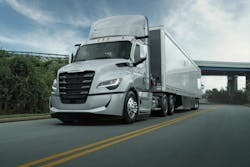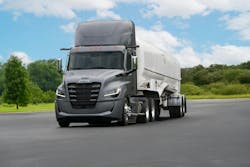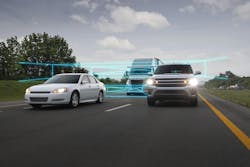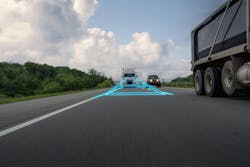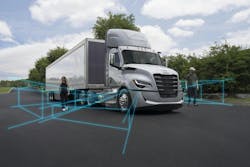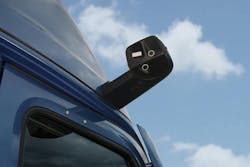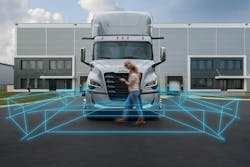Freightliner’s next Cascadia packed with more safety tech and efficiency gains
NASHVILLE, Tennessee—The most popular on-highway tractor in the U.S. will get a refresh next year, packed with more advanced safety technology, increased aerodynamics, and built-in business tools for fleets.
During its annual customer appreciation bash here in Music City, which featured a surprise concert performances by Def Leppard, the Daimler Truck North America OEM gave lucky fleet leaders a first glimpse of the fifth-generation Freightliner Cascadia. The Class 8 truck brand name debuted in 2007 and was most recently remodeled in 2019, continuing to build on Daimler Truck technology and Freightliner loyalty across North America.
“Throughout the years, we've continued to be known for those innovations in the marketplace and by our customers,” Mary Aufdemberg, DTNA GM of product strategy and market development, said during an industry press preview of the truck in Ypsilanti, Michigan, on October 1.
See also: Look back at the Freightliner Cascadia evolution from 2007 to 2025
“But what I love is we never innovate just to innovate,” she continued. “It's always with purpose, and it delivers something meaningful to our customers, which is why today we're still around 40% market share, a leader in the industry, in that on-highway market. We stand proud because we know that means we're doing what we promise and what we deliver, I would say we've become a brand that works for fleets of all sizes.”
Freightliner has sold more than one million Cascadias since 2007, making it the most popular Class 8 truck currently on the road in North America. “When we set out to develop this newest version and build on its legacy of excellence, we listened closely to our customers and what they, their drivers, and their fleets needed,” David Carson, SVP of sales and marketing for DTNA, said. “More safety features, greater efficiency, and increased profitability is what we heard, and it’s what we’re proud to deliver.”
The fifth-generation Freightliner Cascadia is scheduled to begin production mid-2025. Here are some of the efficiency, safety, technology, and business highlights of the new truck:
Efficiency continues to drive Freightliner Cascadia into the future
The previous four generations of the Freightliner Cascadia continued to build on previous fuel efficiency gains, which have led to more than 35% in fuel savings since 2007.
“We fought and looked for every opportunity we could to continue to improve fuel efficiency—this time to the tune of 1.9%,” Greg Treinen, DTNA VP of on-highway market development, said in Ypsilanti on October 1. “The main focus of that 1.9%—really the sole focus—is all aerodynamic improvements. So there’s no new additions to the powertrain. From an efficiency perspective, it was all in with aerodynamics.”
Those new aerodynamics include a new hood design, a redesigned A-pillar deflector, three-piece front wheel well closeouts, a hood-to-bumper seal, and new bumper air ducts that direct airflow around the underbody and tires to increase efficiency. The new Cascadia is also available with an optional Max Aero Bumper, which brings greater efficiency without sacrificing ground clearance, durability, or serviceability, according to DTNA.
Fifth Generation Cascadia powertrain options
Like its predecessors, the fifth-generation Freightliner Cascadia offers a full lineup of engine options to suit the various operational needs of fleets and their drivers.
The Detroit DD13 and DD15 engines will be available at launch, with ratings of up to 505 hp and 1,850 lb.-ft. of torque. The Cummins X15 and X15N, the first natural gas engine designed specifically for heavy-duty and on-highway truck applications, will be available for Cascadias built in 2026. They are available with 400 to 605 hp and 1,450 to 2,050 lb.-ft. of torque.
See also: What's new in Cummins' next diesel X15 engine
More advanced safety features with upgraded hardware
The fifth iteration of the Freightliner Cascadia is the first vehicle equipped with new, expanded Detroit Assurance safety technology. These new updates include better computing power to go with an upgraded camera, four new short-range radar sensors, and an improved long-range radar sensor.
This new suite of sensor hardware enables the Cascadia’s updated safety offerings, including:
Active Brake Assist 6
Detroit’s ABA6 can now deploy automatic braking when detecting vehicles stopped at odd angles, vehicles in curves, and stopped vehicles across multiple lanes. While past ABA versions could recognize moving pedestrians, Daimler said it can now detect stationary pedestrians.
Active Lane Assist 2
Detroit’s ALA2’s new capabilities feature lane change assist, which can help reduce out-of-lane accidents by countersteering if the truck attempts to enter an already occupied lane.
Attentive Driver Protection
When ALA2’s lane-keeping assist is on and active, the truck monitors driver attention through steering wheel input and can initiate a sequence that keeps the Cascadia centered in its lane, slows the vehicle to a stop, and turns on the hazard lights if the driver is not responsive.
Side Guard Assist 2
SGA2 can now detect and warn drivers about objects on the truck’s driver and passenger sides, from the cab to the end of the trailer.
Intelligent Braking Control System
Cascadia’s new intelligent braking control system, or IBCS, combines brake-by-wire technology with backup pneumatics. It employs wheel speed sensors and a chassis-mounted electronic control unit to help create deceleration control.
DTNA also added comfort braking through the IBCS, which provides brake force distribution, lining wear control, and performance monitoring. These features ensure smoother, more confident braking—especially in sudden stops—and help elongate brake pad life through even wear.
Along with comfort braking, IBCS includes endurance braking, which blends the engine retarder and service brakes when the foot pedal is applied, helping to extend brake life further.
The all-new electronic park brake features rollaway mitigation, which automatically applies the parking brake if a driver leaves the seat or opens the door without setting the brake. DTNA engineers noted this feature will help prevent costly and dangerous rollaways.
Dual-stage intelligent LED headlights
New dual-stage intelligent LED headlights feature increased durability and impact resistance. Engineered to melt away ice and eliminate condensation in minutes, the LEDs have an increased beam pattern, an auto high beam feature, and easier beam adjustment capabilities to increase visibility, safety, and driver comfort.
Factory-installed MirrorCam system
The new Freightliner Cascadia offers a factory-installed MirrorCam System. This system uses definition in-cab screens connected to cameras mounted above the doors to provide a wide field of view that can replace traditional side-view mirrors. The camera system is equipped with infrared technology and hydrophobic coatings to repel water and other contaminants.
MirrorCam improves visibility, especially at night and during inclement weather, and driver comfort by minimizing head and neck movement. While federal regulations require DTNA to sell trucks with traditional mirrors, the Federal Motor Carrier Safety Administration can grant fleets waivers to remove them.
Daimler business intelligence built-in
To help improve uptime and furnish greater operational insights, the Cascadia is equipped with advanced technology that enables both new and familiar business intelligence tools.
The newest connected telematics platform, powering Detroit Connect, brings on-the-road benefits for drivers and more real-time information to fleet managers, according to DTNA. Additionally, a new electrical architecture enhances cybersecurity and enables faster processing speeds.
New key features of Detroit Connect include:
-
Detroit Connect Video Capture 2.0 automatically records and captures data during safety events or when initiated by a driver, providing fleet managers with remote access to valuable insights on driver behavior and potential risks. Videos are available near real time through an improved user interface within the Detroit Connect Portal.
-
Remote Lock and Unlock is a new feature derived directly from fleet manager feedback. It allows users to lock and unlock vehicles on demand, reducing roadside assistance costs and increasing vehicle uptime.
-
Geofencing allows customers to create custom-defined geographic areas in the Detroit Connect Portal and receive notifications when vehicles enter or leave that area.
-
Detroit Connect Safety Plus is a subscription service that allows fleet managers to remotely track and receive notifications about the status and health of Detroit Assurance safety systems.
-
Premium Remote Parameter Updates expands the number of parameters available for updates over the air from seven to more than 50.
About the Author
Josh Fisher
Editor-in-Chief
Editor-in-Chief Josh Fisher has been with FleetOwner since 2017. He covers everything from modern fleet management to operational efficiency, artificial intelligence, autonomous trucking, alternative fuels and powertrains, regulations, and emerging transportation technology. Based in Maryland, he writes the Lane Shift Ahead column about the changing North American transportation landscape.
